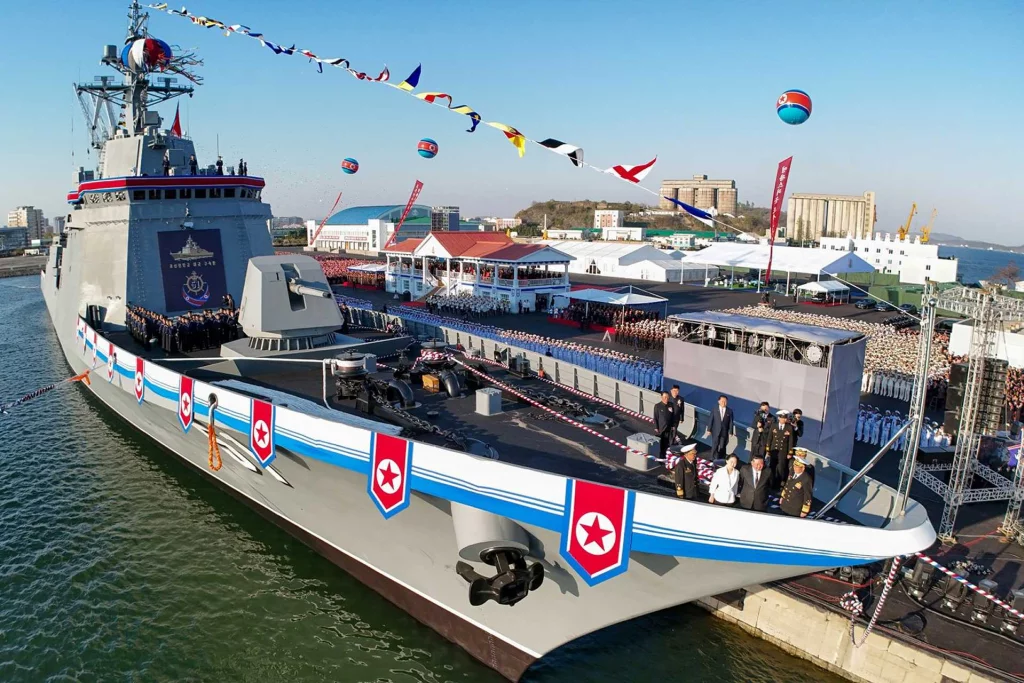North Korea Naval Destroyer Accident: In a rare moment of transparency, North Korean state media reported a serious accident during the launch of a new warship — a 5,000-ton destroyer — on May 21, 2025. The incident took place at the Chongjin Shipyard, a major naval construction site in the northeastern part of the country. What made this event even more significant was the presence of North Korean leader Kim Jong Un, who was attending the ceremony in person when things went wrong.
What Went Wrong at the Ceremony?

According to multiple reports, the destroyer — believed to be part of the Choe Hyon-class, North Korea’s most advanced line of naval ships — tilted and became damaged as it entered the water during the launch. The cause? A failed side-launch maneuver, which is a method used to float large ships into water from the shipyard. This technique, while commonly used worldwide, demands precision — something that may have been lacking due to poor planning or substandard infrastructure.
The accident resulted in the hull of the ship being visibly damaged. While no casualties have been confirmed, the political fallout was swift and intense.
Kim Jong Un’s Reaction on North Korea Naval Destroyer Accident
Kim Jong Un did not hold back in his response. He reportedly called the accident a “serious and unacceptable” incident, even describing it as a “criminal act” driven by what he called “irresponsibility and carelessness.” He immediately ordered the ship to be repaired and completed before a major political gathering in June, underlining how important this destroyer is to North Korea’s military image.
Why North Korea Naval Destroyer Accident Matters
North Korea has been investing heavily in expanding its naval capabilities, and the destroyer is considered a centerpiece of this effort. It’s rumored to be equipped with advanced missile systems and radar technology, making it a critical asset in Pyongyang’s military modernization plans.
This accident not only delays the operational deployment of the warship, but also reflects larger issues within North Korea’s infrastructure and defense manufacturing systems. The country has long struggled with outdated technology, limited access to modern resources, and a lack of experience with complex naval engineering.
A Glimpse Into North Korean Infrastructure Challenges
This isn’t the first time North Korea has experienced technical setbacks. Much of the country’s industrial and military infrastructure dates back to the mid-20th century, largely built during the post-Korean War era with Soviet and Chinese assistance. Over the decades, these systems have aged considerably, and the country’s isolation from international trade and technology has made it difficult to modernize or properly maintain them.
The Bigger Picture: Military Modernization vs. Technical Realities
North Korea’s ambition to modernize its navy is part of a broader push to project power beyond its borders and assert itself in regional waters dominated by more advanced fleets like those of South Korea, Japan, and the United States. The Choe Hyon-class destroyer, which was damaged during the accident, is believed to be a showpiece in this strategy — equipped with advanced radar systems, vertical launch missile cells, and potentially long-range cruise missiles.
However, the accident reveals a widening gap between North Korea’s military aspirations and its ability to execute them with precision and reliability. It underscores the risks of pushing complex engineering projects in a country with limited access to international technical knowledge and modern shipbuilding technology, mostly due to decades-long sanctions and isolation.
The Role of Foreign Assistance and Speculation
This incident has also reignited speculation over whether North Korea has received foreign technical assistance — directly or indirectly — to develop such sophisticated warships. Experts have previously noted the resemblance between some of North Korea’s new military platforms and those used by countries like China or Russia, although no concrete evidence confirms any state-to-state collaboration on naval technology.
Still, even with possible outside influence, the lack of trained personnel, rigorous testing, and safety protocols could have contributed to the failure during the destroyer’s launch. In short, having blueprints and building the ship are one thing — launching it successfully is another.
A Public Relations Setback
From a political standpoint, this was an embarrassing moment for Kim Jong Un. These launch ceremonies are usually highly choreographed, meant to signal strength and progress to both domestic and international audiences. A failed launch — especially in front of the Supreme Leader — disrupts that narrative and potentially sows doubt among elite military ranks and the general population.
By calling the accident a “criminal act,” Kim may be trying to shift blame quickly while signaling his zero-tolerance stance on mistakes in major state projects. It also allows him to reassert authority, showing that errors will be punished regardless of how high up the chain they occur.
Final Thoughts
The May 21 naval accident is more than just a damaged warship — it’s a symbol of the difficult balance North Korea is trying to strike between ambition and ability. While the regime aims to present itself as a formidable military power, events like this reveal underlying structural issues that could hinder progress.
As the damaged destroyer undergoes emergency repairs, the world will be watching how Pyongyang recovers from the mishap — both technically and politically. It remains to be seen whether this will serve as a wake-up call for reform within North Korea’s defense industry, or just another incident quickly buried beneath layers of secrecy.
One thing is certain: accidents like these remind us that even the most secretive states can’t hide the risks that come with pushing their limits.
